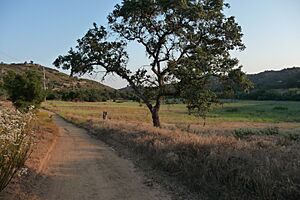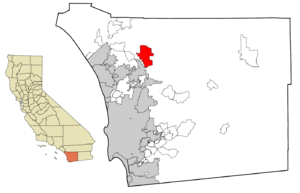Valley Center, California facts for kids
Quick facts for kids
Valley Center
|
|
|---|---|

Valley Center
|
|

Location in San Diego County and the state of California
|
|
| Country | |
| State | |
| County | San Diego |
| Area | |
| • Total | 27.426 sq mi (71.033 km2) |
| • Land | 27.426 sq mi (71.033 km2) |
| • Water | 0 sq mi (0 km2) 0% |
| Elevation | 1,312 ft (400 m) |
| Population
(2010)
|
|
| • Total | 9,277 |
| • Density | 338.256/sq mi (130.601/km2) |
| Time zone | UTC-8 (PST) |
| • Summer (DST) | UTC-7 (PDT) |
| ZIP code |
92082
|
| Area code(s) | 442/760 |
| FIPS code | 06-81736 |
| GNIS feature IDs | 1661616, 2409396 |
Valley Center is a special kind of community in San Diego County, California, United States. It's called a census-designated place (CDP). This means it's an area that the government counts for population, but it's not officially a city. In 2010, about 9,277 people lived there.
Contents
History of Valley Center
In the late 1860s, the area we now call Valley Center was known as Bear Valley. This was because California grizzly bears lived there. These bears are now extinct. In 1866, the biggest grizzly bear ever recorded in California was shot in Valley Center. This bear is even pictured on the Flag of California.
Geography and Climate
Where is Valley Center located?
Valley Center is located in San Diego County, California. The United States Census Bureau says that the area covers about 98.7 square miles (255.6 square kilometers). All of this area is land.
What is Valley Center's climate like?
Valley Center has a warm-summer Mediterranean climate. This type of climate has hot, dry summers and mild, wet winters. It's often called "Csa" on climate maps. On March 30, 2023, a very rare event happened: a tornado warning was issued for the area. Tornadoes are very unusual in this part of the United States.
Who Lives in Valley Center?
Population in 2010
In 2010, Valley Center had a population of 9,277 people. Most people, about 99.6%, lived in homes. A small number lived in group housing or institutions.
There were 1,000 households in Valley Center.
- About 37.3% of these homes had children under 18.
- Many homes (67.8%) were families with married couples.
- The average household had about 3 people.
- The average family had about 3.38 people.
Age groups in 2010
The people in Valley Center were of different ages:
- About 24.3% were under 18 years old.
- About 8.9% were between 18 and 24 years old.
- About 20.9% were between 25 and 44 years old.
- About 33.4% were between 45 and 64 years old.
- About 12.5% were 65 years or older.
The average age in Valley Center was 42.1 years.
Population in 2000
In 2000, Valley Center had 1,323 people. The average household size was 3.01 people. The average family size was 3.33 people.
Age groups in 2000
- About 29.6% were under 18 years old.
- About 6.5% were between 18 and 24 years old.
- About 25.2% were between 25 and 44 years old.
- About 27.4% were between 45 and 64 years old.
- About 11.4% were 65 years or older.
The average age in 2000 was 39 years.
Arts and Culture in Valley Center
Museums to visit
The Valley Center History Museum opened in 2003. It has many interesting things to see, including:
- A stagecoach that was used as an ambulance during the Civil War. It also helped with local transportation and appeared in old Western movies.
- A preserved California Grizzly Bear.
- Other cool items that show the history of the area.
Fun events in Valley Center
Valley Center has some fun yearly events:
- On Memorial Day weekend, the town holds the Valley Center Stampede Rodeo and Festival. This event honors fallen veterans.
- Every year, the town celebrates its Western heritage with the Valley Center Western Days Parade and Country Fair.
Notable People from Valley Center
Many famous people have lived in or been connected to Valley Center:
- June Allyson, actress
- Fred Astaire, actor and dancer
- Glen Bell, who started the Taco Bell restaurant chain
- Fred Biletnikoff, a former football player for the Oakland Raiders
- Louis Bromfield, an author
- Daniel Brunskill, an NFL offensive tackle
- J.J. Cale, a musician
- Gary Cooper, an actor
- Kevin Craft, a former UCLA quarterback
- Billy Cundiff, an NFL kicker
- John DeLorean, a famous car maker
- Gary Garrison, a former football player for the San Diego Chargers
- Kirby Grant, an actor and rancher
- Jack Haley, the actor who played the Tin Man in The Wizard of Oz
- Charles Hatfield, known as a "rainmaker"
- Mike Leake, an MLB pitcher
- Katie Leclerc, an actress
- Denise Mueller-Korenek, a cyclist and world speed record holder
- Merle Oberon, an actress
- Dick Powell, an actor
- Steve Reeves, the actor who played Hercules
- Trevor Reilly, a former NFL linebacker
- Irene Ryan, the actress who played Granny on The Beverly Hillbillies
- Sean Salisbury, a former NFL quarterback and sports analyst
- Randolph Scott, an actor
- John Wayne, a famous actor
- Lawrence Welk, an American accordion player and bandleader
- Mae West, an actress
- Carol Williams, an international concert organist
- Sam Zimbalist, a movie producer
Images for kids
See also
 In Spanish: Valley Center para niños
In Spanish: Valley Center para niños


